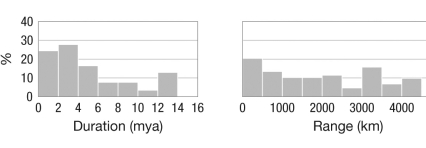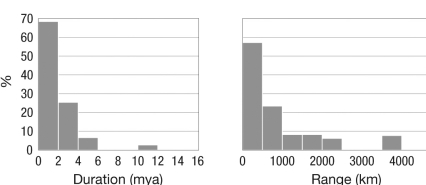Multiple Choice
What does this figure tell about the differences in extinction probabilities between planktotrophic and nonplanktotrophic species? Planktotrophic
Nonplanktotrophic
A) Planktotrophic species tend to have relatively long durations and large geographic ranges, while nonplanktotrophic species have short durations and small geographic ranges.
B) Planktotrophic species tend to have relatively long durations and small geographic ranges, while nonplanktotrophic species have short durations and large geographic ranges.
C) Planktotrophic species tend to have relatively short durations and large geographic ranges, while nonplanktotrophic species have long durations and small geographic ranges.
D) Planktotrophic species tend to have relatively short durations and small geographic ranges, while nonplanktotrophic species have long durations and large geographic ranges.
Correct Answer:

Verified
Correct Answer:
Verified
Q39: What effect of mass extinctions is described
Q40: Alison Boyer (2008) analyzed data on the
Q41: How did the cause(s) of the K-Pg
Q42: Fossil evidence from the Cambrian period indicated
Q43: Which of the following scenarios may produce
Q44: Why is the Permian mass extinction event
Q45: The history of life on Earth as
Q46: Yellowstone National Park in the United States
Q48: Which of the following conditions favors fossilization?<br>A)
Q49: Explain the difference between preserving "species diversity"